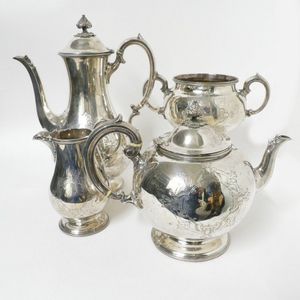Victorian Silver Bachelor's Tea Set
You must be a subscriber, and be logged in to view price and dealer details.
Subscribe Now to view actual auction price for this item
When you subscribe, you have the option of setting the currency in which to display prices to $Au, $US, $NZ or Stg.
- Georgian - As an English stylistic period, Georgian is usually taken to cover the period from George I (1714) to the Regency of Prince George (1811-20), although the period from 1800 to 1830 is sometimes designated as the Regency period. During the Georgian period the great English cabinetmakers and designers such as Chippendale, Hepplewhite, Adam Sheraton etc., were all active.
Therefore there isn't a single 'Georgian style' as such and to say something is 'Georgian', usually means it was made between 1714 and 1830. This assumes we discount George V and George VI, both being from the 20th century.
The styles popular at the time of each reign were:
George I (1714-1727) saw out the last years of the Baroque period.
George II (1727-1760) reigned during the Rococo period.
George III (1760-1820) saw the last gasp of the Rococo, all of the early Neo-Classic 'Adam style' and most of the later neo-Classic 'Regency style'.
George IV (Prince Regent 1820-1830)encompassed the last of the 'Regency' style.
William IV's reign (1830-1837) was something of a no man's land (stylistically) and he wasn't a 'George' anyway. He covered the last glimmerings of 'Regency' and the start of the 'Victorian' style. - Victorian Period - The Victorian period of furniture and decorative arts design covers the reign of Queen Victoria from 1837 to 1901. There was not one dominant style of furniture in the Victorian period. Designers used and modified many historical styles such as Gothic, Tudor, Elizabethan, English Rococo, Neoclassical and others, although use of some styles, such as English Rococo and Gothic tended to dominate the furniture manufacture of the period.
The Victorian period was preceded by the Regency and William IV periods, and followed by the Edwardian period, named for Edward VII (1841 ? 1910) who was King of the United Kingdom and the British Dominions and Emperor of India for the brief period from 1901 until his death in 1910.
This item has been included into following indexes:
- tea sets/services
Visually similar items

A Victorian silver three piece coffee service, elegant baluster form, embossed with scrolls and florals, vacant cartouche to each, leaf decorated scroll handles, each piece raised on an open scroll and bead apron and four conforming legs, the coffee pot wi

A Victorian sterling silver three piece silver tea service, maker's mark Samuel Hayne & Dudley Carter / London, circa 1848-1849, comprising a teapot, a sugar vessel and a creamer, each with a lobed body, 1442grs. Total weight, the teapot 19 cm high

A Victorian silver four-piece tea and coffee service, the coffee pot with plain baluster body, the teapot of bullet shape, conforming sugar basin and milk jug, all with engraved vacant cartouches. Sheffield 1868 by Martin Hall Ltd. Total weight 2228gm

Late 19th century Chinese silver export ware three piece tea service, circular shape with dragon handles finials and body decoration (teapot hinge detached, sugar bowl lid with splitting, two pieces marked to the base. Provenance: from the collection of Su
